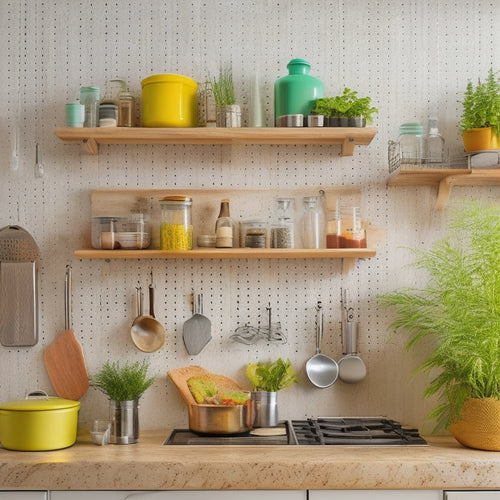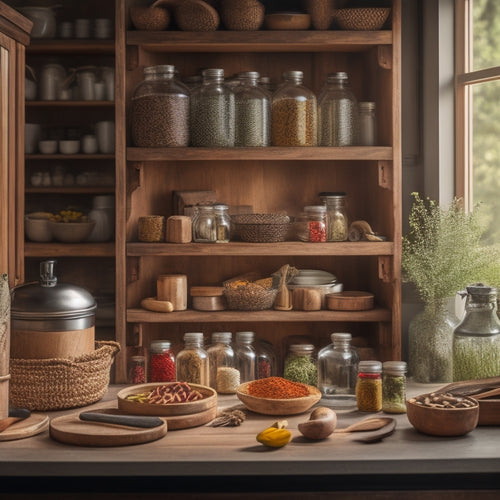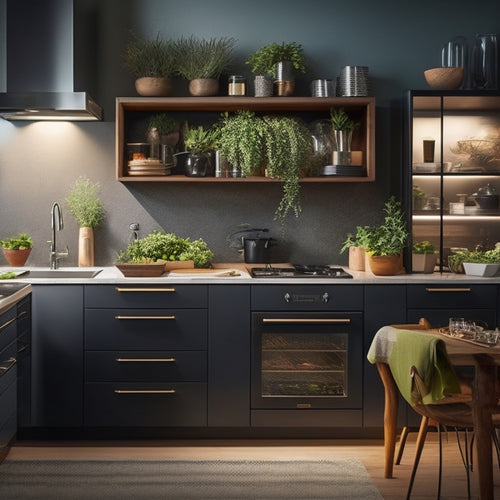
Optimize Your Small Kitchen Cabinets in 5 Steps
Share
You're about to discover the secret to a more efficient and visually appealing small kitchen by optimizing your cabinets in 5 straightforward steps. Start by evaluating your kitchen cabinet space, measuring dimensions, and identifying work zones. Next, remove unwanted items, keeping only essentials and categorize them into groups like baking supplies and cooking utensils. Assign zones for easy access, labeling each zone clearly, and maximize vertical storage space with shelves, hooks, or a pegboard. By following these steps, you'll create a streamlined kitchen where everything has its place, and you'll be amazed at how much more you can fit - and find - in your small kitchen cabinets.
Key Takeaways
• Assess your kitchen cabinet space by visually mapping the layout, identifying dimensions, and considering work zones for optimal use.
• Remove unwanted kitchen items, keeping only essentials and sorting them into categories for efficient storage.
• Categorize kitchen essentials wisely, grouping similar items together and establishing a hierarchy for easy access.
• Assign zones for easy access, designating specific areas for each category of essentials and labeling them clearly.
• Maximize vertical storage space by installing shelves, hooks, or a pegboard to utilize every available inch.
Assess Your Kitchen Cabinet Space
Take stock of your kitchen cabinet space by standing back and visually mapping out the layout, identifying the dimensions, door swings, and any obstacles that might impact your design. As you assess, consider the 'work zones' in your kitchen, such as cooking, prep, and storage areas. Note how these zones interact with your cabinet space.
Measure your cabinet dimensions carefully, including the width, height, and depth of each cabinet. Record these measurements to reference later. Think about the storage layout you want to achieve, considering the items you need to store and how you want to access them. Will you need pull-out shelves or baskets for easy access? Do you have any fixed obstacles, like plumbing or electrical outlets, that might affect your design?
As you assess your cabinet space, remember to think vertically as well as horizontally. Consider the space above and below your cabinets, and how you can maximize storage in these areas.
Remove Unwanted Kitchen Items
Clear out the clutter by purging kitchen items that are broken, outdated, or no longer used, freeing up valuable cabinet space for the essentials. This essential step in your decluttering strategy will help you tackle kitchen clutter and create a more organized, functional space.
Take everything out of your cabinets and sort items into three piles: keep, donate/sell, and discard. Be ruthless – if you haven't used it in the past year, it's probably safe to get rid of it. Consider the 80/20 rule: 80% of the time, you likely use 20% of your kitchen items. Focus on keeping only the items that fall into that 20%.
As you sort, think about the items you use daily, like your favorite coffee mug or go-to cooking utensils. These are the items that deserve prime cabinet real estate. By removing unwanted items, you'll create a more streamlined kitchen that's easier to navigate and more efficient to work in.
Categorize Kitchen Essentials Wisely
Now that you've purged your kitchen cabinets of unwanted items, categorize your remaining essentials into groups, such as baking supplies, cooking utensils, and dinnerware, to create a functional and visually appealing layout. This essential clustering will help you establish a kitchen hierarchy, where frequently used items are easily accessible and less-used items are stored away.
Imagine your kitchen cabinets as a well-organized store, where similar items are grouped together, making it easy to find what you need when you need it. For instance, store all your baking essentials, like mixing bowls, measuring cups, and baking sheets, in one area. This way, when you're whipping up a cake, you can quickly grab what you need without rummaging through your entire cabinet.
Similarly, group your cooking utensils, like pots, pans, and cooking spoons, together for easy access. By categorizing your essentials wisely, you'll be able to create a kitchen that's not only visually appealing but also highly functional, making it a joy to cook and serve others.
Assign Zones for Easy Access
Designate specific zones within your kitchen cabinets to house each category of essentials, ensuring that frequently used items are stored in easy-to-reach locations, while less-used items are relegated to higher or lower shelves. This personalized layout will make it easier for you to access what you need when you need it, saving you time and energy.
Label each zone with clear, descriptive labels, so you can quickly identify what's inside. For example, you might've a 'Baking Zone' with all your baking supplies, a 'Cooking Zone' with pots and pans, and a 'Dining Zone' with plates and glasses. This visual system will help you and others navigate your kitchen with ease.
Maximize Vertical Storage Space
Maximize Vertical Storage Space
By installing shelves, hooks, or a pegboard, you can capitalize on the often-wasted vertical space in your kitchen cabinets, doubling or even tripling your storage capacity. This is especially important in small kitchens where every inch counts.
| Storage Solution | Benefits |
|---|---|
| Shelf Dividers | Keep similar items organized, easy to find, and prevent clutter from building up |
| Hooks | Hang items like pots, pans, utensils, and even bags, freeing up shelf space |
| Corner Carousels | Make the most of the often-hard-to-reach corner spaces, making it easy to access items |
Frequently Asked Questions
What Is the Ideal Cabinet Shelf Height for Optimal Storage?
When designing your cabinet layout, you'll want to think about ideal shelf heights for best storage. Typically, you'll want shelf spacing around 12-18 inches apart, allowing you to easily access and store items of varying sizes.
Can I Use Open Shelving Instead of Traditional Cabinets?
You're a master chef with a million cookbooks, but can you ditch traditional cabinets for open shelving? Absolutely! Open shelving creates visual balance, showcasing your personal style, and makes it easy to access frequently used items, making serving others a breeze.
How Do I Handle Corner Cabinets With Dead Space?
You'll love corner solutions like carousels, lazy susans, or diagonal shelves that transform dead space into functional storage. These space savers help you access hidden areas, keeping your kitchen organized and clutter-free.
Are Soft-Close Cabinet Drawers Really Worth the Investment?
"Thou shalt not settle for mediocre cabinetry! You're investing in a luxury feel, so opt for soft-close cabinet drawers, featuring sleek cabinet hardware that whispers shut, exuding sophistication and refinement in every subtle movement."
Can I Repurpose Old Furniture as Kitchen Cabinets?
You can breathe new life into old furniture by repurposing it as kitchen cabinets, embracing an Upcycled Chic or Vintage Revamp aesthetic. Sand, stain, and refinish to create a unique, functional space that serves others with character and charm.
Related Posts
-

Stylish Pegboard Storage for Open Kitchen Concepts
Stylish pegboard storage can completely enhance your open kitchen concept, merging practicality with contemporary fla...
-

Revolving Cabinet Organizer Lazy Susan
A revolving cabinet organizer like a Lazy Susan is a transformative solution for your kitchen. It maximizes space and...
-

Smart Kitchen Countertop Storage Innovations
Smart kitchen countertop storage innovations are transformative for maximizing your kitchen's potential. You can clea...


